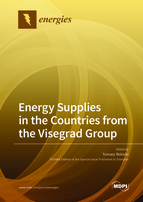Energy Supplies in the Countries from the Visegrad Group
A special issue of Energies (ISSN 1996-1073). This special issue belongs to the section "C: Energy Economics and Policy".
Deadline for manuscript submissions: closed (30 April 2022) | Viewed by 32858
Special Issue Editor
Interests: energy economy; micro- and macro-economy; economic geography; logistics (above all transport problems); management of information
Special Issues, Collections and Topics in MDPI journals
Special Issue Information
Dear Colleagues,
The Visegrad Group (V4) is an association of four Central European countries – Poland, the Czech Republic, Slovakia, and Hungary. The group aimed to deepen cooperation between these countries, and, in the initial phase, in particular, concerning accession to the structures of the European Union and NATO. The Visegrad Group was established in 1991 by three countries (Poland, Hungary, and Czechoslovakia) forming the so-called Visegrad Triangle. Later, as a result of the dissolution of Czechoslovakia (on January 1, 1993), the Czech Republic and Slovakia became members of the group. The V4 countries had similar goals for their foreign policy, but also similar possibilities for its implementation. These countries belonged to the former communist bloc, which was best prepared for the market economy. Additionally, they represented a very similar level of socio-economic development.
This issue welcomes papers relating to energy supply in the Visegrad countries. Studies can cover both macroeconomic and microeconomic aspects. It is important to define how the V4 countries cope with energy management, how they have undergone or are going through the energy transformation, and in which direction they are going. The articles may concern aspects of the use of energy sources, energy security, social and economic aspects of energy, the impact of energy consumption on the environment, and modern solutions in the energy sector. It is also possible to present a comparison of changes in the energy situation in the V4 countries compared to other European countries, both economically developed and developing.
Dr. Tomasz Rokicki
Guest Editor
Manuscript Submission Information
Manuscripts should be submitted online at www.mdpi.com by registering and logging in to this website. Once you are registered, click here to go to the submission form. Manuscripts can be submitted until the deadline. All submissions that pass pre-check are peer-reviewed. Accepted papers will be published continuously in the journal (as soon as accepted) and will be listed together on the special issue website. Research articles, review articles as well as short communications are invited. For planned papers, a title and short abstract (about 100 words) can be sent to the Editorial Office for announcement on this website.
Submitted manuscripts should not have been published previously, nor be under consideration for publication elsewhere (except conference proceedings papers). All manuscripts are thoroughly refereed through a single-blind peer-review process. A guide for authors and other relevant information for submission of manuscripts is available on the Instructions for Authors page. Energies is an international peer-reviewed open access semimonthly journal published by MDPI.
Please visit the Instructions for Authors page before submitting a manuscript. The Article Processing Charge (APC) for publication in this open access journal is 2600 CHF (Swiss Francs). Submitted papers should be well formatted and use good English. Authors may use MDPI's English editing service prior to publication or during author revisions.
Keywords
- Energy supplies
- Visegrad Group countries
- Energy performance
- Energy efficiency
- Energy security
- Circular economy
- Energy market
- Social and economic aspects of energy
- Impact of energy consumption on the environment
- Directions of energy development






